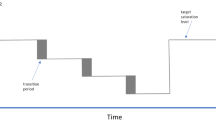Abstract
Respiratory rate (RR) is a key vital sign that has been traditionally employed in the clinical assessment of patients and in the prevention of respiratory compromise. Despite its relevance, current practice for monitoring RR in non-intubated patients strongly relies on visual counting, which delivers an intermittent and error-prone assessment of the respiratory status. Here, we present a novel non-invasive respiratory monitor that continuously measures the RR in human subjects. The respiratory activity of the user is inferred by sensing the thermal transfer between the breathing airflow and a temperature sensor placed between the nose and the mouth. The performance of the respiratory monitor is assessed through respiratory experiments performed on healthy subjects. Under spontaneous breathing, the mean RR difference between our respiratory monitor and visual counting was 0.4 breaths per minute (BPM), with a 95% confidence interval equal to [− 0.5, 1.3] BPM. The robustness of the respiratory sensor to the position is assessed by studying the signal-to-noise ratio in different locations on the upper lip, displaying a markedly better performance than traditional thermal sensors used for respiratory airflow measurements.










Similar content being viewed by others
References
Addison PS, Watson JN, Mestek ML, Mecca RS. Developing an algorithm for pulse oximetry derived respiratory rate (RRoxi): a healthy volunteer study. J Clin Monit Comput. 2012;26(1):45–51.
Addison PS, Watson JN, Mestek ML, Ochs JP, Uribe Alberto A, Bergese Sergio D. Pulse oximetry-derived respiratory rate in general care floor patients. J Clin Monit Comput. 2014;29(1):113–20.
Cavalcante AN, Martin YN, Sprung J, Imsirovic J, Weingarten TN. Low minute ventilation episodes during anesthesia recovery following intraperitoneal surgery as detected by a non-invasive respiratory volume monitor. J Clin Monit Comput. 2017;32(5):929–35.
Cretikos MA, Bellomo R, Hillman K, Chen J, Finfer Simon, Flabouris Arthas. Respiratory rate: the neglected vital sign. Med J Aust. 2008;188(11):657–9.
Dahan A, Aarts L, Smith TW. Incidence, reversal, and prevention of opioid-induced respiratory depression. Anesthesiology. 2010;112(1):226–38.
Folke M, Cernerud L, Ekström M, Hök B. Critical review of non-invasive respiratory monitoring in medical care. Med Biol Eng Comput. 2003;41(4):377–83.
Güder F, Ainla A, Redston J, Mosadegh B, Glavan Ana, Martin TJ, Whitesides George M. Paper-based electrical respiration sensor. Angewandte Chemie Int Ed. 2016;55(19):5727–32.
Guechi Y, Pichot A, Frasca D, Rayeh-Pelardy F, Lardeur Jean-Yves, Mimoz Olivier. Assessment of noninvasive acoustic respiration rate monitoring in patients admitted to an emergency department for drug or alcoholic poisoning. J Clin Monit Comput. 2015;29(6):721–6.
Hochhausen N, Barbosa Pereira C, Leonhardt S, Rossaint R, Czaplik Michael. Estimating respiratory rate in post-anesthesia care unit patients using infrared thermography: an observational study. Sensors. 2018;18(5):1618.
Hogan J. Why don’t nurses monitor the respiratory rates of patients? Br J Nurs. 2006;15(9):489–92.
Knaus WA, Zimmerman JE, Wagner DP, Draper EA, Lawrence DE. APACHE-acute physiology and chronic health evaluation: a physiologically based classification system. Crit Care Med. 1981;9(8):591–7.
Lee LA, Caplan RA, Stephens LS, Posner KL, Terman Gregory W, Voepel-Lewis Terri, Domino Karen B. Postoperative opioid-induced respiratory depression. Anesthesiology. 2015;122:659–65.
Lee PJ. Clinical evaluation of a novel respiratory rate monitor. J Clin Monit Comput. 2016;30:175–83.
Li MH, Yadollahi A, Taati B. Noncontact vision-based cardiopulmonary monitoring in different sleeping positions. IEEE J Biomed Health Inform. 2017;21(5):1367–75.
Loughlin PC, Sebat F, Kellett JG. Respiratory rate: the forgotten vital sign - make it count!. Jt Comm J Qual Patient Saf. 2018;44(8):494–9.
Lu W, Nystrom MM, Parikh PJ, Fooshee DR, Hubenschmidt James P, Bradley Jeffrey D, Low Daniel A. A semi-automatic method for peak and valley detection in free-breathing respiratory waveforms. Med Phys. 2006;33(10):3634–6.
Mimoz O, Benard T, Gaucher A, Frasca D, Debaene B. Accuracy of respiratory rate monitoring using a non-invasive acoustic method after general anaesthesia. Br J Anaesth. 2012;108(5):872–5.
van Gastel M, Stuijk S, de Haan G. Robust respiration detection from remote photoplethysmography. Biomed Opt Express. 2016;7(12):4941–57.
Voscopoulos C, Brayanov J, Ladd D, Lalli M, Panasyuk Alexander, Freeman Jenny. Evaluation of a novel noninvasive respiration monitor providing continuous measurement of minute ventilation in ambulatory subjects in a variety of clinical scenarios. Anesth Analg. 2013;117(1):91–100.
Wang S, Pohl A, Jaeschke T, Czaplik M, Köny M, Leonhardt S, Pohl N. A novel ultra-wideband 80 ghz fmcw radar system for contactless monitoring of vital signs. In: 2015 37th annual international conference of the IEEE engineering in medicine and biology society (EMBC). IEEE; 2015. pp. 4978–4981.
Zhang Xuezheng, Kassem Mahmoud Attia Mohamed, Zhou Ying, Shabsigh Muhammad, Wang Quanguang, Xuzhong Xu. A Brief Review of Non-invasive Monitoring of Respiratory Condition for Extubated Patients with or at Risk for Obstructive Sleep Apnea after Surgery. Frontiers in Medicine. 2017;4(March):1–6.
Acknowledgements
Authors gratefully acknowledge the support and assistance of Dr. Fernando Altermatt and Dr. Maria Rodriguez-Fernandez in the human pilot study, and the insightful discussions about respiratory monitoring with Dr. Carolina Cabrera.
Funding
This research project was funded by Fundación Copec-UC Grant 2015.R.557 and by CORFO-Innova Grant 17ITE2-72695 awarded to DH and AA.
Author information
Authors and Affiliations
Corresponding author
Ethics declarations
Conflict of interest
Authors declare no conflict of interest.
Ethical approval
All procedures performed in studies involving human participants were in accordance with the ethical standards of the institutional ethics committee of the Pontificia Universidad Católica de Chile (Project ID 170523007, approved October 19th, 2017). All subjects provided written informed consent to participate.
Additional information
Publisher's Note
Springer Nature remains neutral with regard to jurisdictional claims in published maps and institutional affiliations.
Rights and permissions
About this article
Cite this article
Hurtado, D.E., Abusleme, A. & Chávez, J.A.P. Non-invasive continuous respiratory monitoring using temperature-based sensors. J Clin Monit Comput 34, 223–231 (2020). https://doi.org/10.1007/s10877-019-00329-5
Received:
Accepted:
Published:
Issue Date:
DOI: https://doi.org/10.1007/s10877-019-00329-5




